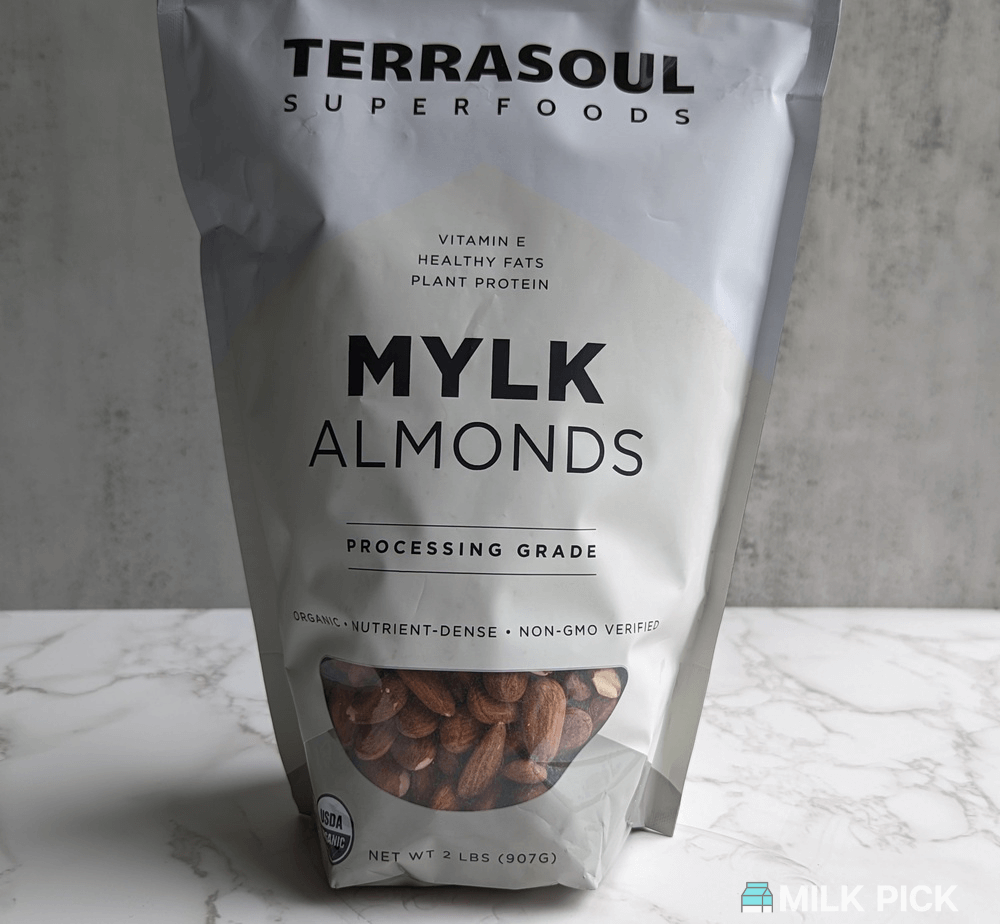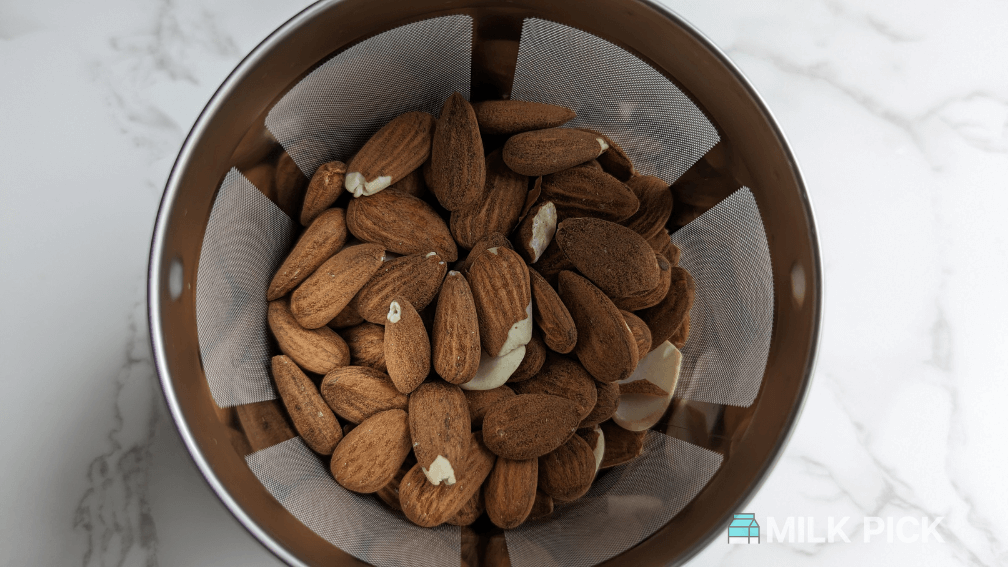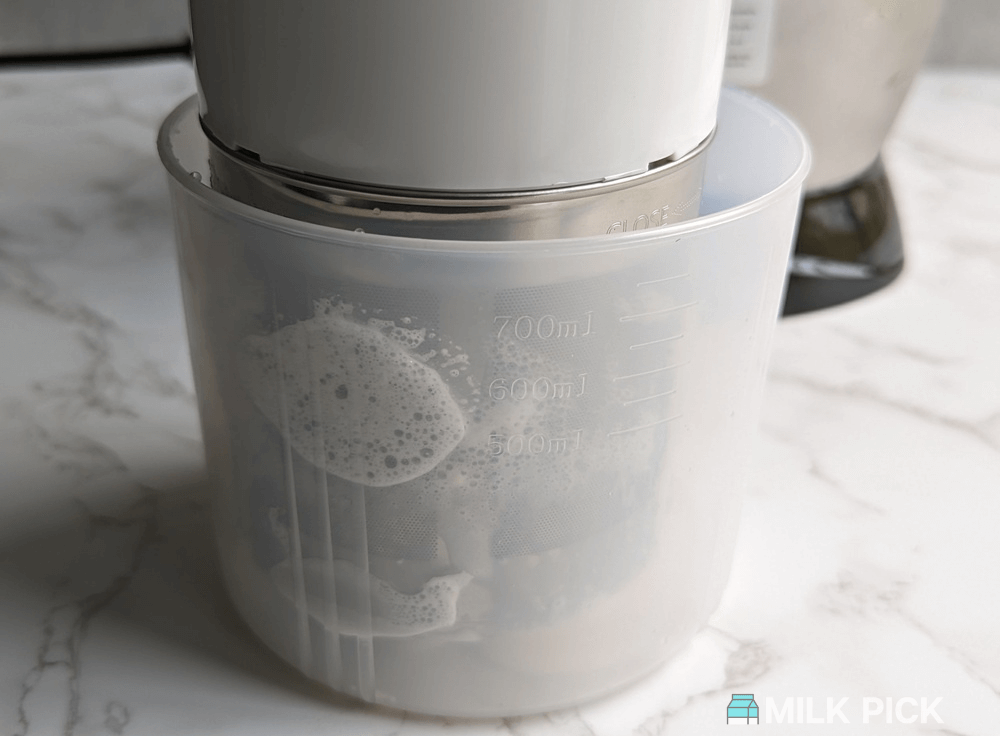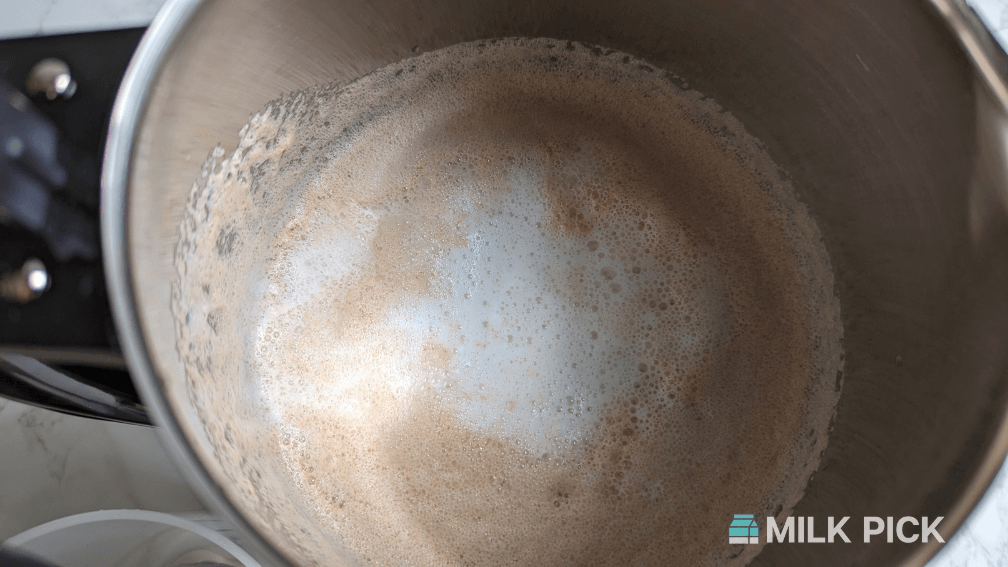In my never-ending quest to find the perfect machine to make almond milk, I recently decided to try the Tribest Soyabella nut milk maker.
It’s one of the most popular milk-making machines on Amazon, with 1200+ reviews and a 4-star rating.
And while the product has “soy” in the name, it does a lot more than just making soy milk.
Here’s my review of the Tribest Soyabella and whether or not I’d recommend it.
What is The Soyabella?
The Tribest Soyabella is marketed as an automatic soy and nut milk making machine.
One of the original use cases for the Soyabella is to make soy milk (hints the name). The key to this is its heating function.
Traditionally, to make soy milk, you:
- Soak soybeans in water
- Blend the soybeans with water
- Strain the mixture into a pot
- Heat the mixture in a pot
- Let the soy milk cool, then strain it again with a nut milk bag
It’s a fairly labor-intensive process.
With the Soyabella, you just add your soybeans to the screen cup, fill the basin with water, and run the machine on HOT mode. After about 20 minutes, you should have a batch of fresh soy milk.
The Soyabella also cuts down on the time needed to make nut milks like almond and cashew milk.
You can use the Soyabella to make a wide range of other things from soups to smoothies and tons of hot drinks.
Tribest Soyabella Unboxing
The Soyabella comes with a few different parts.
[parts photo]
- Carafe: This is the stainless steel container you pour water into to make plant-based milk.
- Motor head: The top/lid and grinding blade are attached as one piece.
- Screens: You get two screens—fine and course. These attach to the motor head to grind nuts, soybeans, or whatever else you want to milk. The “fine” filter is for making vegan milk, and the “coarse” one is for thicker beverages like soups and creams.
- Grinding cup: A plastic cup you can use to grind dry ingredients into powder. This attaches to the motor head as well.
- Measuring cup: A plastic measuring cup to measure your ingredients.
- Drip cup: You can place the used screens in this cup to catch any drips.
- Cleaning tools: It also comes with a cleaning brush and scrubber.
- Instructions/recipe books: The instructions for how to use the Soyabella and a book of 40+ recipes.
The main parts you’re going to need are the carafe, motor head, screens, and drip cup.
You may also need the grinding cup if you just want to grind ingredients up instead of making milk.
The build quality of the Soyabella is decent. It doesn’t have a “luxury” or premium feel, but it also doesn’t feel cheap.
Most of the parts that come into contact with food like the blade, screens, and carafe are made from stainless steel, which is more sanitary and makes them easier to clean.
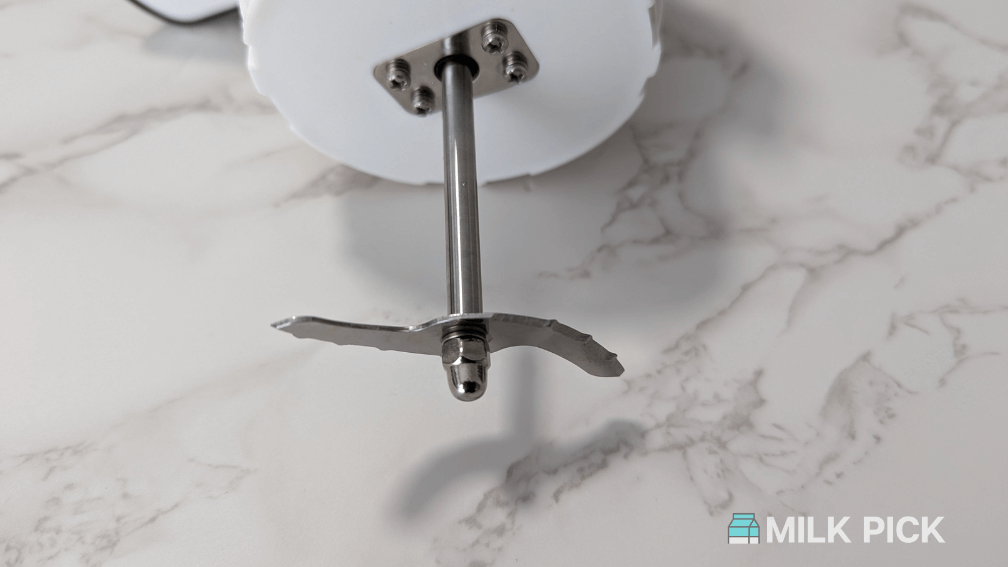
As for the size, it’s somewhere between the size of a tea kettle and an average-sized blender.
How The Soyabella Works
Here’s how the Soyabella works for making vegan milk.
- Fill the carafe with water (there’s a minimum and maximum line).
- Add your milk base (almonds, cashews, etc.) to the screen (use the fine screen to make milk).
- Insert the motor head into the screen and twist to close it. Then place it into the carafe.
- Press the “Raw” button, and the Soyabella’s 220-watt motor grinds the nuts into the water. You may have to repeat this step a few times to grind the nuts as much as possible.
Because the screen has such small holes, it filters the ground nuts so no particles leak into the water.
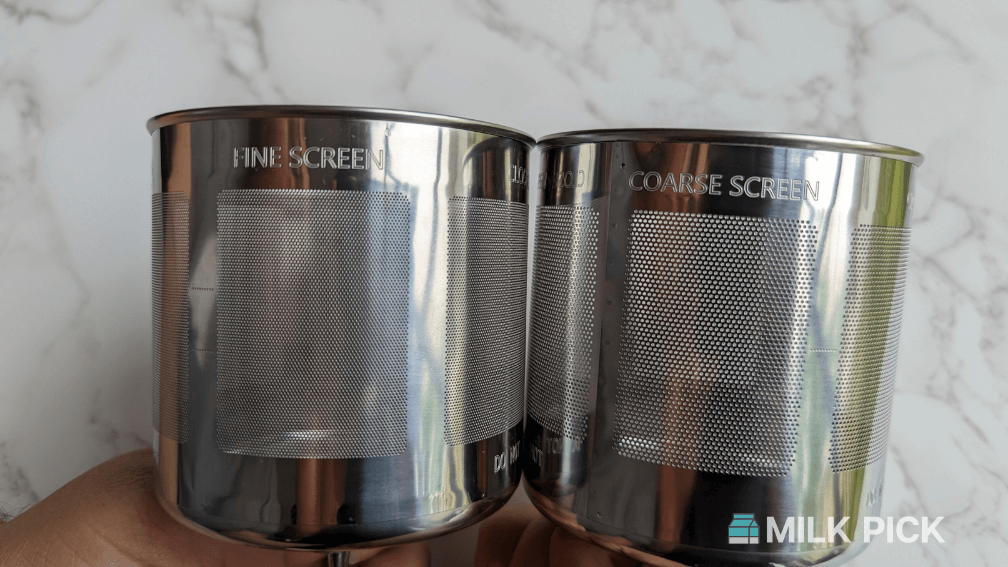
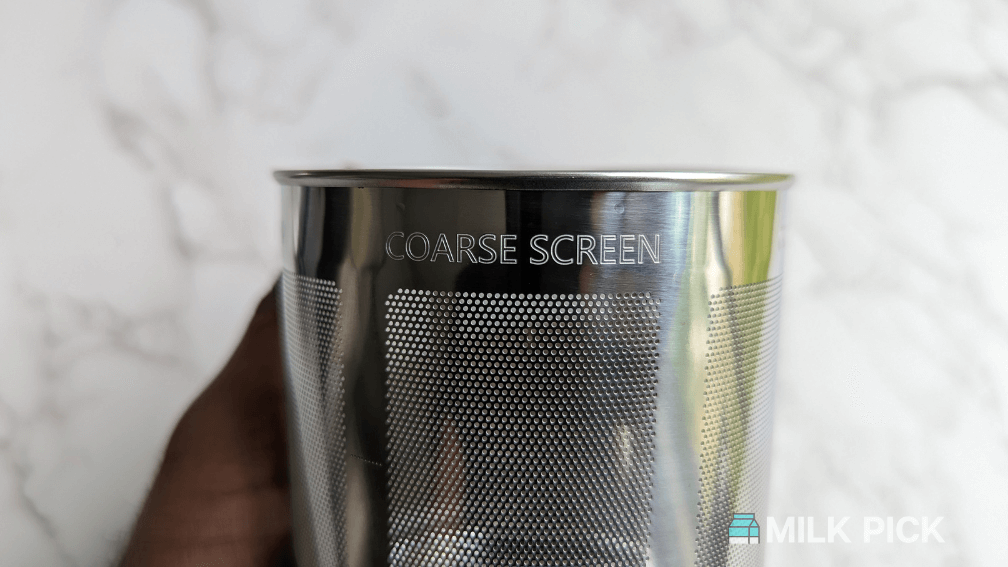
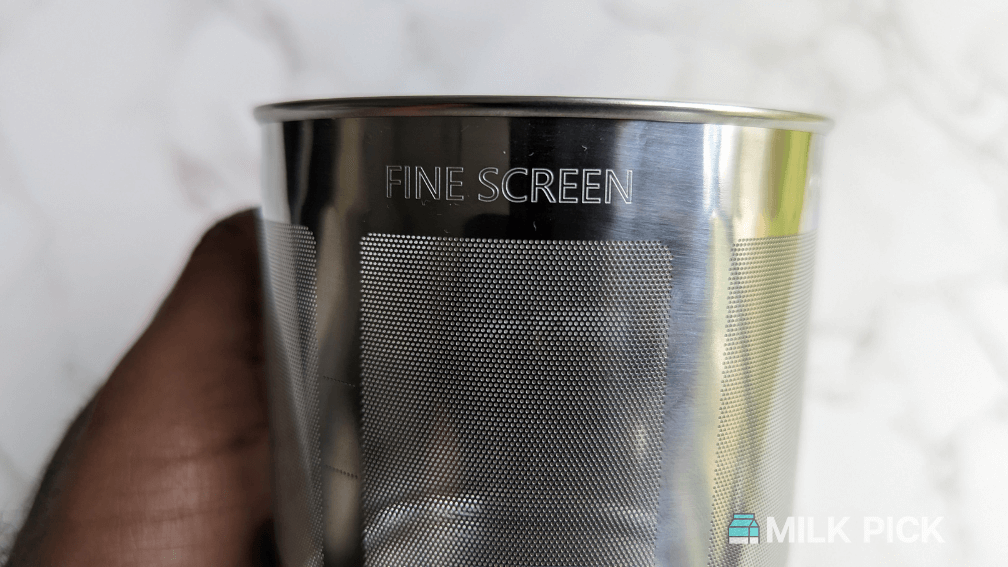
Once you’ve gotten your milk to the consistency you want, remove the screen from the basin and pour the milk from the carafe into your container of choice and store it in the fridge.
The process is simple, but I ran into some bumps along the way.
With that, let’s dive into my experience using the Soyabella.
Testing The Soyabella
For this review, I used the Soyabella to make almond milk.
The Soyabella instructions recommend soaking the almonds for the best results, but it also works with raw ingredients.
So I made two batches of almond milk—one with unsoaked almonds and one with soaked almonds.
Unsoaked Almonds
First up was the unsoaked almonds.
I used the Terrasoul Mylk almonds.
I filled the basin with about four cups of water (per the instructions), which was slightly over the minimum line.

Then I filled the fine screen with a cup of raw almonds.
This is where I had my first issue with the Soyabella.
After you fill the screen with almonds, you’re supposed to shove the motor head and blade portion into the same cup.
The problem is that the blade doesn’t go straight into the cup. You have to jiggle the almonds around the blade to make it fit and close.
Here's what the raw almonds look like in the screen with the grinder blade.
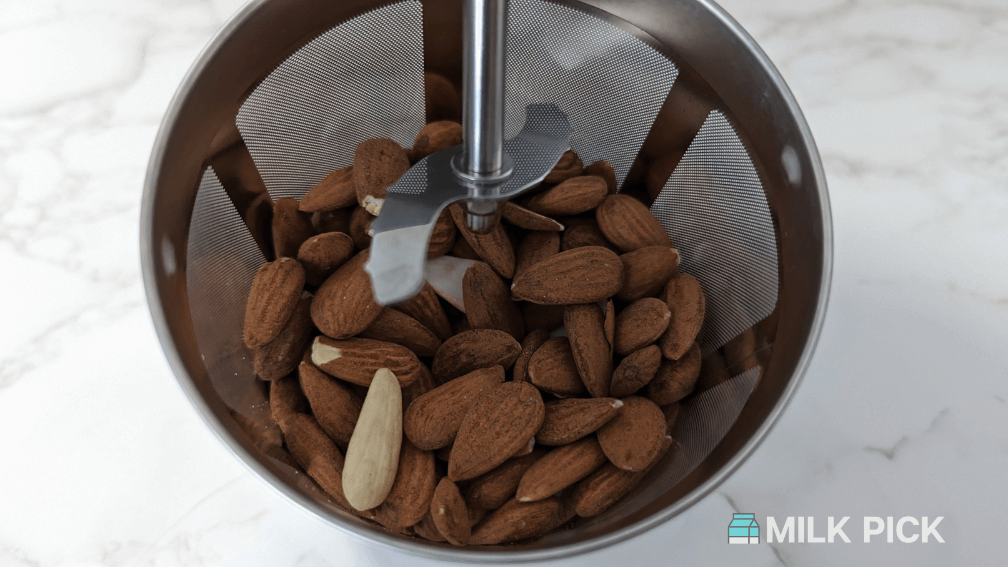
If you were to just push the blade straight down into the screen, here's how far it goes (without moving the almonds around).

After moving the blade around a bit, I finally got it to close and added it to the carafe.
Placing the motor head onto the carafe was also a little weird. I expected the motor head to “click” in place, but that wasn’t the case. I just pushed down until it felt secure.
Now it was time to turn on the Soyabella and make some almond milk.
According to the instructions, you just have to press the “RAW” button, and the machine runs for ~15 seconds.
Once it’s done, the top light should turn green. At that point, they recommend running the machine a few more times to grind the almonds up even more.
However, the light never turned green for me.
The machine ran for less than 10 seconds, stopped, and the light flashed red. I ran four cycles of this, expecting a green light at some point.
Once I realized there was no green light, I removed the motor head to check out the milk.
Here’s what it looked like in the carafe.
One of the best ways to judge the effectiveness of a nut-milk machine is by looking at the leftover pulp. Here’s what it looked like with the Soyabella.

It was relatively dry, but I could’ve extracted more liquid if I ran it through a nut milk bag.
I was curious about how much almond milk the Soyabella made, so I poured it into a measuring bowl.
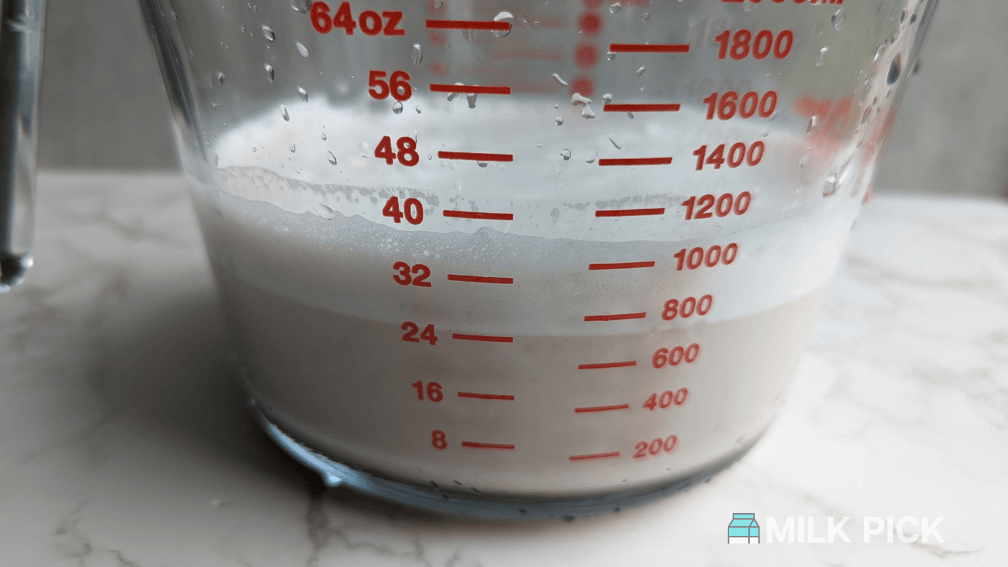
Minus the thick layer of foam on top, the Soyabella made 24 ounces of almond milk.
For reference, I typically get 32 ounces of almond milk when using a blender and nut milk bag with the same recipe.
Here's a video of how I make almond milk in a blender.
The consistency of the almond milk was pretty smooth. There were no chunks or curdling, which is great.
Here’s a better look at the almond milk poured into my Milk Pick mug.

Soaked Almonds
Next, I tried the Soyabella with soaked almonds.
This is where things got frustrating.
I added my soaked almonds to the screen and immediately noticed a problem.
The almonds filled pretty much the entire cup!
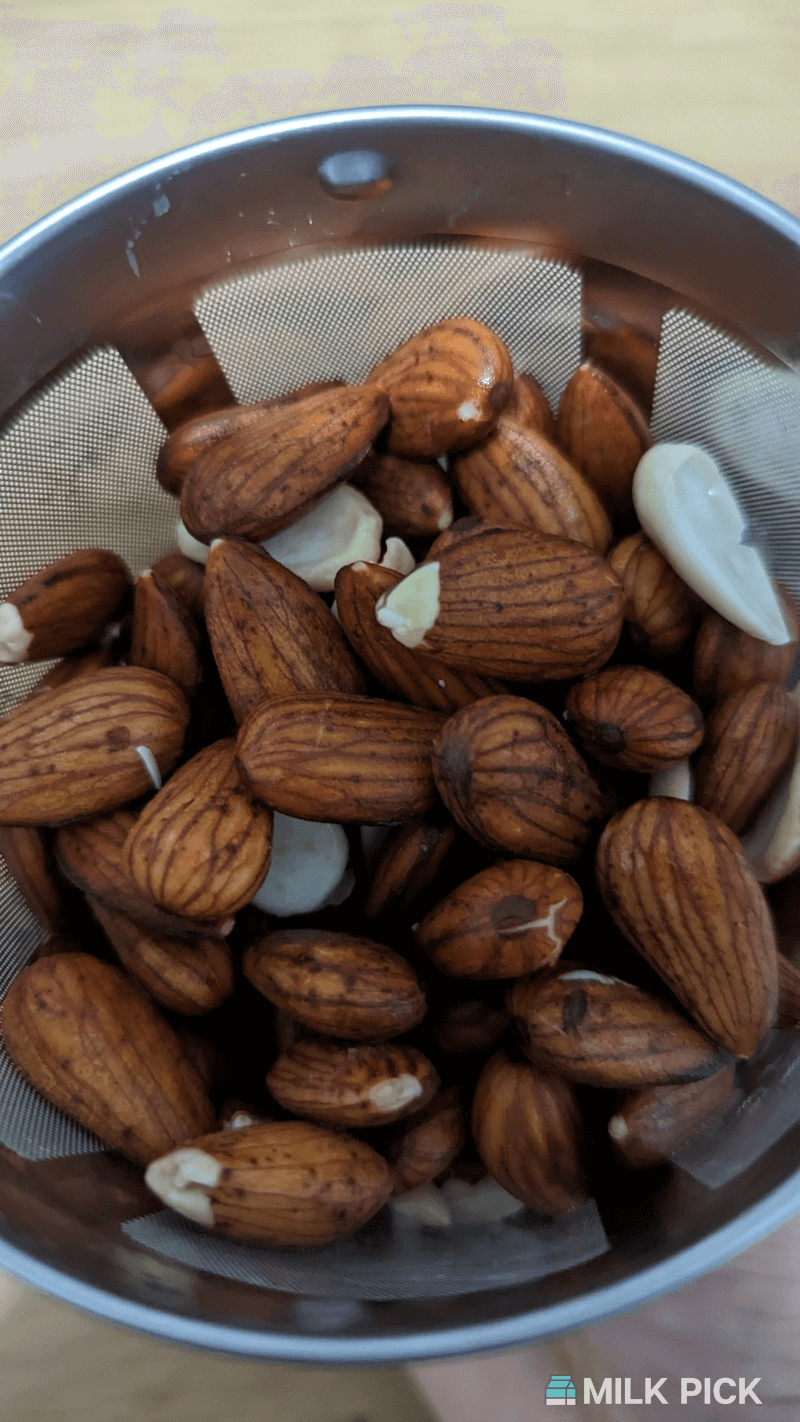
I wrestled with the blade for about five minutes before I was somehow able to get it into the screen and close it.
Since the cup was so full, I ran the machine for more cycles this time. After five cycles, I removed the filter and poured the almond milk into a container.
It made the same amount of almond milk as the unsoaked almonds (24 ounces).
However, the Soyabella wasn’t able to fully break down the almonds this time.
Here’s what the pulp looked like afterward.
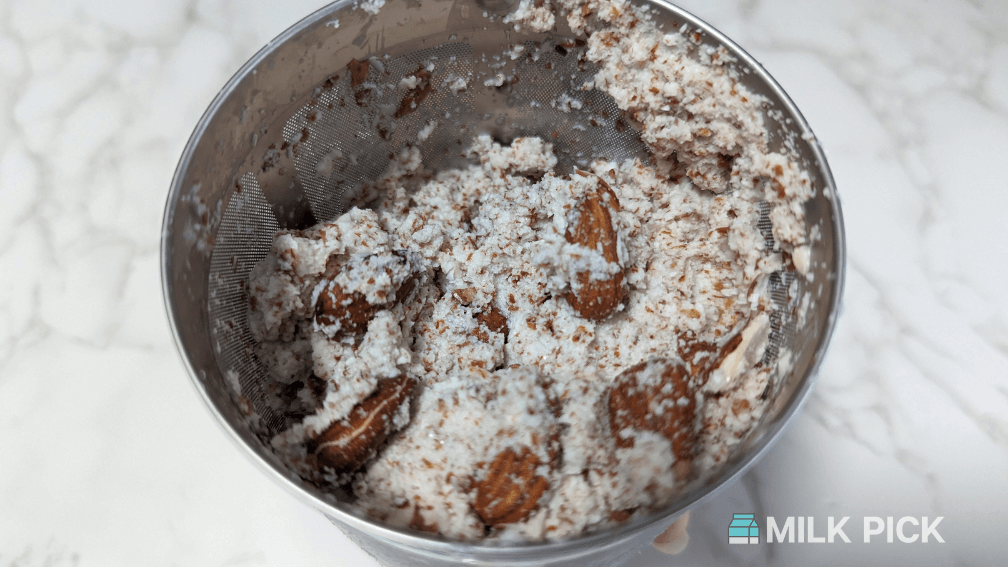

As you can see, there are still whole almonds left in the screen—not ideal.
Running the machine a few more times may have crushed these almonds.
But there’s no way of knowing the almonds aren’t fully crushed until it’s done, and you’ve removed the screen.
Soyabella Pros
Here’s what I liked about the Tribest Soyabella.
Speed
The Soyabella promises nut milk in as little as 30 seconds. When it comes to the actual blending process, I found that to be pretty accurate.
The most time-consuming part of using the Soyabella was attaching the motor head to the screen. But once you do that, it blends quickly.
When I use a blender to make almond milk, I typically blend the mixture for about one minute, then strain it, which takes about another minute.
The Soyabella grinds and “strains” the almonds simultaneously, making the process faster.
Relatively Quiet
While it’s not silent by any means, it’s noticeably quieter than other appliances that grind and blend things.
The Soyabella registered at 83.1 decibels in my test.
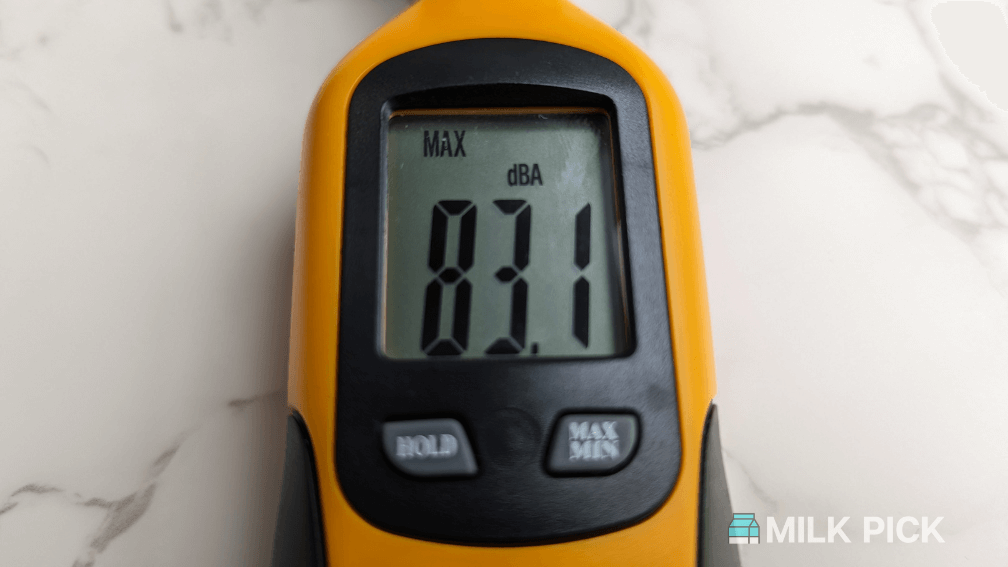
For comparison, when I reviewed the Nutr, that machine registered at 97.8 decibels.
Appliance | Noise Level (Decibels) |
|---|---|
Soyabella | 83.1 |
Nutr | 97.8 |
Nutribullet | 98.1 |
On top of that, since the Soyabella doesn’t need to run as long as the Nutr or Nutribullet to make almond milk, there’s less noise involved overall.
Again, this isn’t a “silent” kitchen appliance, but I didn’t find it disturbingly loud.
Easy to Clean
If you saw my Nutr review, one of my issues was the cleaning process.
That wasn’t the case with the Soyabella. Even though it has a few different parts, cleaning it was pretty easy.
I recommend cleaning it immediately after use. Since most of the parts are made of steel, letting them sit covered in residue from your recipes can dull the steel and make them harder to clean later.
Tip: For a thorough clean, use the included scrubbing brush and pad on the screen to make sure deposits don’t form in the tiny holes.
Versatility
I only used the Soyabella for almond milk, but it does a lot more. It can make soup, tea, hot cocoa, flour, and even tofu (depending on the model).
I could see this being useful for people who don’t have access to a stove/oven, but still want to make meals without relying on a microwave.
For instance, college students living in dorms or people in micro-apartments might gravitate towards something like this since all you need is an electrical outlet.
Simple to Use
Aside from my issue with the motor head, the Soyabella is simple to use.
It only has two options—RAW and HOT.

So while the Soyabella can make a bunch of different things, it does it using only a couple of buttons.
The simplicity of just pushing one of two options is pretty convenient—particularly for people who aren’t well-versed in the kitchen.
Soyabella Cons
Here’s what I didn’t like about the Soyabella.
Major Design Flaw
This flaw was a dealbreaker for me.
The way you insert the motor head/blade into the filter cup is terrible. I don’t know who thought shoving a blade through a cup of nuts was a good idea.
It wasn’t as difficult with raw almonds, but trying to get the thing to close using soaked almonds was a terrible experience.
I was curious if I was doing something wrong, but when I looked at the Soyabella reviews on Amazon, I noticed it’s a common issue.
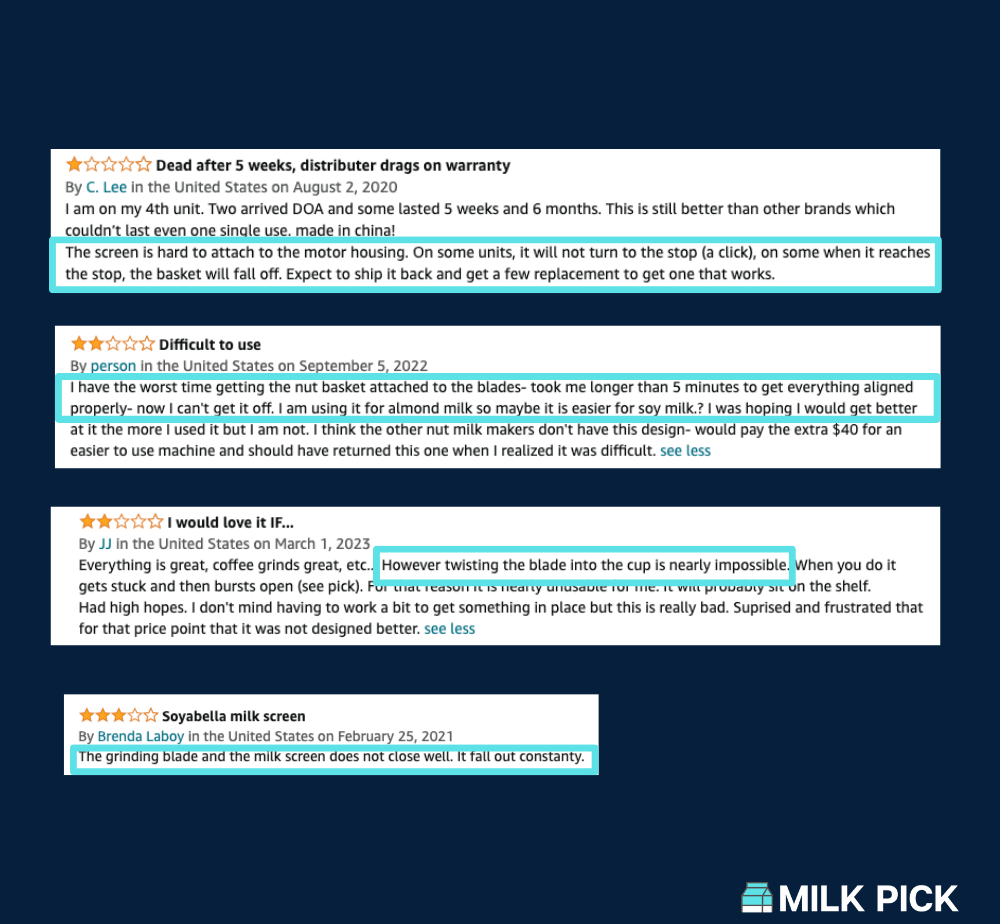
If you like to soak your almonds before making almond milk (which I recommend), you may have a difficult time using the Soyabella.
Doesn’t Make as Much Milk
I can make about eight more ounces of almond milk using a blender than I made with the Soyabella.
You might get more milk if you run more cycles (closer to 10). But following the instruction manual, the most I made was ~24 ounces.
Doesn’t Fully Strain The Pulp
The almond pulp was still pretty wet after running the Soyabella about five times. This could be a problem if you want to repurpose the pulp into flour or use it in other recipes.
The dryer your pulp, the easier it is to use it in other things (particularly turning it into flour).
Again, you can try running it through more cycles to dry the pulp even more.
No “Finish” Indicator
The instructions say the power light should turn green when the Soyabella is finished with a cycle. It also says it runs for about 15 seconds per cycle.
Neither of those was the case for me. There was no green light, and the machine ran for less than 10 seconds per cycle. Plus, it seemed like the cycles were different lengths each time.
The only way to tell if your plant-based milk (or whatever you’re making) is done is to remove the motor head and check it yourself.
It would be great if the machine ran for a set period of time each cycle and clearly indicated when it was finished.
Should You Buy The Soyabella?
Overall, the Soyabella is an ok nut milk maker machine.
I could see it being useful for people who want a quick way to make plant-based milk with the option to make other things as well. Particularly if you don’t (or can’t) manually strain milk through a nut milk bag.
It’s reasonably priced compared to nut milk machines, and the lack of options is actually a benefit in my opinion.
However, I can’t get past the issue of how difficult it is to connect the motor head to the screen cup. I wouldn’t use this machine again for that reason alone.
But if that’s not an issue for you, or you plan to use it with raw nuts only, then this could be a decent option.


